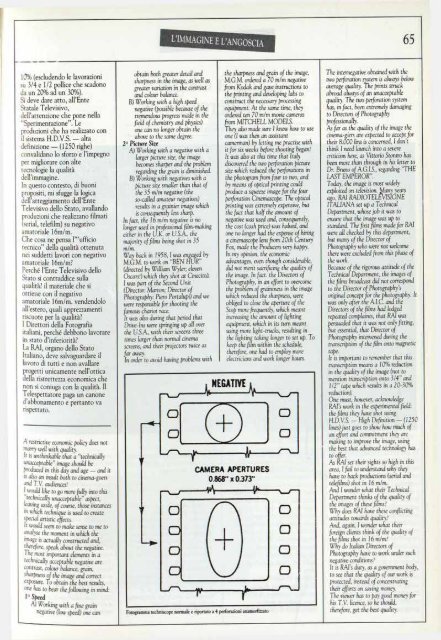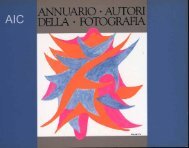AIC, 1988 - AIC Associazione Italiana Autori della Fotografia ...
AIC, 1988 - AIC Associazione Italiana Autori della Fotografia ...
AIC, 1988 - AIC Associazione Italiana Autori della Fotografia ...
Create successful ePaper yourself
Turn your PDF publications into a flip-book with our unique Google optimized e-Paper software.
<strong>AIC</strong><br />
10% (escludendo le lavorazioni<br />
su 3/4 e 1/2 pollice che scadono<br />
da un 20% ad un 30%).<br />
Si deve dare atto, all'Ente<br />
Statale Televisivo,<br />
dell'attenzione che pone nella<br />
"Sperimentazione". Le<br />
produzioni che ha realizzato con<br />
il sistema H.D.V.S. — alta<br />
definizione — (1250 righe)<br />
convalidano lo sforzo e l'impegno<br />
per migliorare con alte<br />
tecnologie la qualità<br />
dell'immagine.<br />
In questo contesto, di buoni<br />
propositi, mi sfugge la logica<br />
dell'atteggiamento dell'Ente<br />
Televisivo dello Stato, avallando<br />
produzioni che realizzano filmati<br />
(serial, telefilm) su negativo<br />
amatoriale 16m/m.<br />
Che cosa ne pensa T'ufficio<br />
tecnico" <strong>della</strong> qualità ottenuta<br />
nei suddetti lavori con negativo<br />
amatoriale 16m/m?<br />
Perché l'Ente Televisivo dello<br />
Stato si contraddice sulla<br />
qualità? il materiale che si<br />
ottiene con il negativo<br />
amatoriale 16m/m. vendendolo<br />
all'estero, quali apprezzamenti<br />
riscuote per la qualità?<br />
I Direttori <strong>della</strong> <strong>Fotografia</strong><br />
italiani, perché debbono lavorare<br />
in stato d'inferiorità?<br />
La RAI, organo dello Stato<br />
Italiano, deve salvaguardare il<br />
lavoro di tutti e non avallare<br />
progetti unicamente nell'ottica<br />
<strong>della</strong> ristrettezza economica che<br />
non si coniuga con la qualità. Il<br />
Telespettatore paga un canone<br />
d'abbonamento e pertanto va<br />
rispettato.<br />
A restrictive economic policy does not<br />
marry well with quality.<br />
It is unthinkable that a "technically<br />
unacceptable" image should be<br />
produced in this day and age — and it<br />
is also an insult both to cinema-goers<br />
and T.V. audiences!<br />
I would like to go more fully into this<br />
"technically unacceptable" aspect,<br />
leaving aside, of course, those instances<br />
in which technique is used to create<br />
special artistic effects.<br />
It would seem to make sense to me to<br />
analyse the moment in which the<br />
image is actually constructed and,<br />
therefore, speak about the negative.<br />
The most important elements in a<br />
technically acceptable negative are<br />
contrast, colour balance, grain,<br />
sharpness of the image and correct<br />
exposure. To obtain the best results,<br />
one has to bear the following in mind:<br />
1° Speed<br />
A) Working with a fine grain<br />
negative (low speed) one can<br />
obtain both greater detail and<br />
sharpness in the image, as well as<br />
greater variation in the contrast<br />
and colour balance.<br />
B) Working with a high speed<br />
negative (possible because of the<br />
tremendous progress made in the<br />
field of chemistry and physics)<br />
one can no longer obtain the<br />
above to the same degree.<br />
2° Picture Size<br />
A) Working with a negative with a<br />
larger picture size, the image<br />
becomes sharper and the problem<br />
regarding the grain is diminished.<br />
B) Working with negatives with a<br />
picture size smaller than that of<br />
the 35 m/m negative (the<br />
so-called amateur negatives)<br />
results in a grainier image which<br />
is consequently less sharp.<br />
In fact, the 16 m/m negative is no<br />
longer used in professional film-making<br />
either in the U.K. or U.S.A., the<br />
majority of films being shot in 35<br />
m/m.<br />
Way back in 1958,1 was engaged by<br />
M.G.M. to work on "BEN HUR"<br />
(directed by William Wyler; eleven<br />
Oscars!) which they shot at Cinecittà.<br />
I was part of the Second Unit<br />
(Director: Marton; Director of<br />
Photography: Piero Portalupi) and we<br />
were responsible for shooting the<br />
famous chariot race.<br />
It was also during that period that<br />
Drive-Ins were springing up all over<br />
the U.S.A, with their screens three<br />
times larger than normal cinema<br />
screens, and their projectors twice as<br />
far away.<br />
In order to avoid having problems with<br />
L'IMMAGINE E L'ANGOSCIA 65<br />
a<br />
a<br />
o<br />
o<br />
o<br />
o<br />
-r-<br />
the sharpness and grain of the image,<br />
M.G.M. ordered a 70 m/m negative<br />
from Kodak and gave instructions to<br />
the printing and developing labs to<br />
construct the necessary processing<br />
equipment. At the same time, they<br />
ordered ten 70 m/m movie cameras<br />
from MITCHELL MODELS.<br />
They also made sure I knew how to use<br />
one (I was then an assistant<br />
camerman) by letting me practise with<br />
it for six weeks before shooting began!<br />
It was also at this time that Italy<br />
discovered the two perforation picture<br />
size which reduced the perforations in<br />
the photogram from four to two, and<br />
by means of optical printing could<br />
produce a squeeze image for the four<br />
perforation Cinemascope. The optical<br />
printing was extremely expensive, but<br />
the fact that half the amount of<br />
negative was used and, consequently,<br />
the cost (cash price) was halved, and<br />
one no longer had the expense of hiring<br />
a cinemascope lens from 20th Century<br />
Fox, made the Producers very happy.<br />
In my opinion, the economic<br />
advantages, even though considerable,<br />
did not merit sacrificing the quality of<br />
the image. In fact, the Directors of<br />
Photography, in an effort to overcome<br />
the problem of graininess in the image<br />
which reduced the sharpness, were<br />
obliged to close the aperture of the<br />
Stop more frequently, which meant<br />
increasing the amount of lighting<br />
equipment, which in its turn meant<br />
using more light-trucks, resulting in<br />
the lighting taking longer to set up. To<br />
keep the film within the schedule,<br />
therefore, one had to employ more<br />
electricians and work longer hours.<br />
NEGATIVE<br />
m 4h<br />
CAMERA APERTURES<br />
0.868" x 0.373"<br />
Fotogramma techniscope normale e riportato a 4 perforazioni anamorfinato<br />
o<br />
o<br />
O<br />
O<br />
a<br />
O<br />
The intemegative obtained with the<br />
two perforation system is always below<br />
average quality. The prints struck<br />
abroad always of an unacceptable<br />
quality. The two perforation system<br />
has, in fact, been extremely damaging<br />
to Directors of Photography<br />
professionally.<br />
As far as the quality of the image the<br />
cinema-giers are expected to accept for<br />
their 8.000 lira is concerned, 1 don't<br />
think 1 need launch into a severe<br />
criticism here, as Vittorio Storaro has<br />
been more than through in his letter to<br />
Dr. Bruno of A.G.I.S., regarding "THE<br />
LAST EMPEROR".<br />
Today, the image is most widely<br />
exploited on television. Jvdany years<br />
ago, RAI RADIOTELEVISIONE<br />
ITALIANA set up a Technical<br />
Department, whose job it was to<br />
ensure that the image was up to<br />
standard. The first films made for RAI<br />
were all checked by this department,<br />
but many of the Director of<br />
Photography who were not welcome<br />
there were excluded from this phase of<br />
the work.<br />
Because of the rigorous attitude of the<br />
Technical Department, the images of<br />
the films broadcast did not correspond<br />
to the Director of Photography's<br />
original concept for the photography. It<br />
was only after the A.I.C. and the<br />
Directors of the films had lodged<br />
repeated complaints, that RAI was<br />
ersuaded that it was not only fitting,<br />
ut essential, that Director of<br />
Photography intervened during the<br />
transcription of the film onto magnetic<br />
tape.<br />
It is important to remember that this<br />
transcription means a 10% reduction<br />
in the quality of the image (not to<br />
mention transcription onto 3/4" and<br />
112" tape which results in a 20-30%<br />
reduction).<br />
One must, however, acknowledge<br />
RAl's work in the experimental field:<br />
the films they have shot using<br />
H.D.V.S. - High Definition - (1250<br />
lines) just goes to show how much of<br />
an effort and commitment they are<br />
making to improve the image, using<br />
the best that advanced technology has<br />
to offer.<br />
As RAI set their sights so high in this<br />
area, I fail to understand why they<br />
have to back productions (serial and<br />
telefilms) shot in 16 m/m.<br />
And 1 wonder what their Technical<br />
Department thinks of the quality of<br />
the images of these films?<br />
Why does RAI have these conflicting<br />
attitudes towards quality<br />
And, again, I wonder what their<br />
foreign clients think of the quality of<br />
the films shot in 16 m/m.'<br />
Why do Italian Directors of<br />
Photography have to work under such<br />
negative conditionsÌ<br />
It is RAI's duty, as a government body,<br />
to see that the quality of our work is<br />
protected, instead of concentrating<br />
their efforts on saving money.<br />
The viewer has to pay good money for<br />
his T.V. licence, so he should,<br />
therefore, get the best quality.









